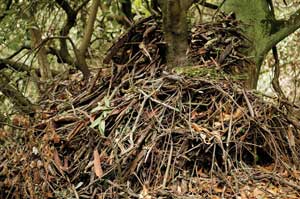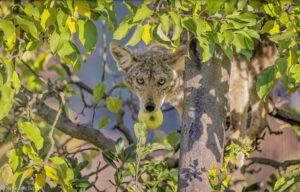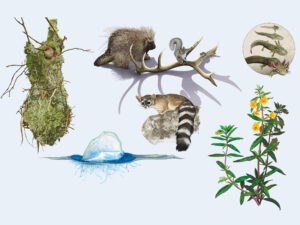When you stroll around the Lafayette Reservoir or walk to Jewel Lake in Tilden Park, you might come across some curious mounds of sticks in the woods along the trail. Some are low and dome-shaped; some might be up to six feet tall and pointed like tepees. Who builds such things? Turns out it’s a rat—our native dusky-footed woodrat.
If you could see inside a woodrat’s house, you’d find a tidy little home: a nest bedroom or two lined with grasses and shredded bark; a pantry full of acorns and other seeds, leaves, and twigs for food; and several latrines for waste (a woodrat poops over 100 pellets a day!). The nests might have a few scattered California bay leaves to repel fleas. Food items that can be toxic when fresh (such as toyon leaves) are kept in a separate room to age before the rats move them to the pantry. When the latrines get full, woodrats clean house, shoving the pellets out into the forest, where they fertilize the soil.
When you see one house, look for others nearby. The daughters of female woodrats usually build or take over nests near their mothers’, creating maternal neighborhoods of extended, multigenerational families. Some mothers “bequeath” their own nests to a son or daughter, then go to live in a second home nearby. But some father woodrats are literally driven up a tree-forced out of the female home after mating. They sometimes then build smaller nests in nearby trees.
Woodrats share their houses with other animals, including mice, lizards, salamanders, snails, the occasional snake, and two kinds of ticks. Scientists have most closely studied the ticks, since they can infect people with the serious illness Lyme disease. The woodrat tick does not usually bite people, but it is responsible for keeping the bacteria that causes Lyme disease present in woodrat populations. It’s the western black-legged tick that can spread the disease from woodrats to humans. So don’t investigate an occupied nest too closely!
- Woodrat nest. Photo by Paul Furman.
If you could look inside, you might find out why these rodents are also called packrats. Like their human counterparts, woodrats store lots of seemingly useless items in their homes: We have found tennis balls, eyeglasses, and Bic lighters and pens in abandoned nests in the Tilden Nature Area. Woodrat houses near mining camps and cabins elsewhere in the West have contained silverware, dentures, boots, and even dynamite caps.
Though they are large for a rodent (10 to 19 inches, including the tail), you’ll probably never see a wild woodrat in the flesh. They’re nocturnal, and even the light of a full moon is enough to keep them at home. But if you approach a nest at twilight, listen for the rattling sound woodrats make with their tails when excited or disturbed. It lasts for a few seconds, and can be heard from as far as 45 feet away.
It’s not every day that you go looking for rats, but if you want to meet a dusky-footed woodrat in the flesh, visit the Lindsay Wildlife Museum in Walnut Creek. Lindsay’s rat isn’t on exhibit regularly, but the staff will gladly bring her out for special events, educational presentations, or a simple meet-and-greet [(925)935-1978].
At Lafayette Reservoir in the East Bay or Pulgas Ridge Open Space Preserve in the hills above San Carlos, you’ll see more woodrat nests than you can shake a stick at. Both the reservoir’s paved 2.7-mile Lakeside Trail loop and Pulgas Ridge’s aptly named Dusky-Footed Woodrat Trail (two miles) will remind you that the hills do have eyes—and stick nests [reservoir; Pulgas Ridge Open Space Preserve].
At Tilden Park’s Environmental Education Center, you can see an exhibit with a “step-in” nest—put your head inside and come face to face with a woodrat [(510)525-2233]. The Oakland Museum also offers a peek inside a woodrat’s home in one of its cutaway dioramas, revealing the nests’ construction and the maze of chambers inside.
Seeing a wild woodrat is tough to do, but Chris Wemmer has managed to catch the creatures on film using specially-rigged cameras. His “Camera Trap Codger” blog includes posts about his rat neighbors [search for “dusky-footed woodrat”]. Those cameras are pretty fancy, but if you’re camping in woodrat habitat, bring along a piece of flat tin. Hold it over the campfire, so it gets covered in soot. Set it out overnight, and you’ll have a collection of tracks in the morning—and maybe a few from a woodrat! [Matthew Bettelheim]





